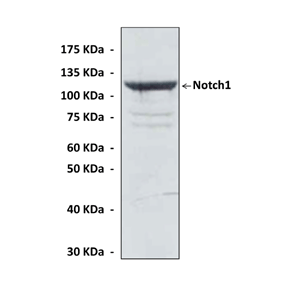Anti-Notch1: Polyclonal Notch1 Antibody |
 |
BACKGROUND Notch receptors play a critical role in lineage specification decisions in development. Physiologic activation of Notch receptors (Notch 1–4) triggered by interaction with a DSL ligand expressed on the surface of a neighboring cell induces two consecutive proteolytic cleavages in the receptor, first by an ADAM metalloprotease and subsequently by the γ-secretase complex, which release the intracellular portion of the Notch protein from the membrane.1 This fragment (“intracellular Notch” or ICN) rapidly translocates to the nucleus and interacts with the CSL DNA binding protein to activate the expression of target genes.2 Thus, Notch receptors operate both as recipients of extracellular signals at the cell surface and as transcription factors regulating gene expression in the nucleus. Notch1 signaling is involved in the maintenance of hematopoietic stem cells and is essential for the development of T cells.3 The key role of Notch1 in T cell development is involved in regulating cell growth, proliferation, differentiation, and apoptosis, processes that when dysregulated are the hallmark of cancer in developing thymocytes. Inhibition of Notch1 signaling with small molecule inhibitors of the γ-secretase complex (GSI) induces cell cycle arrest and apoptosis in leukemic cells.
REFERENCES
1. Artavanis-Tsakonas S et al.: Science 284: 770-776, 1999.
2. Oswald F et al.: Mol. Cell. Biol. 21: 7761–74, 2001.
3. Laky K & Fowlkes BJ: Curr. Opin. Immunol. 20: 197-202, 2008.
2. Oswald F et al.: Mol. Cell. Biol. 21: 7761–74, 2001.
3. Laky K & Fowlkes BJ: Curr. Opin. Immunol. 20: 197-202, 2008.
Products are for research use only. They are not intended for human, animal, or diagnostic applications.
Параметры
Cat.No.: | CA1215 |
Antigen: | Human Notch1 C-terminal sequence. |
Isotype: | Rabbit Polyclonal |
Species & predicted species cross- reactivity ( ): | Human, Rat, Mouse |
Applications & Suggested starting dilutions: | WB 1:1000 IP 1:50 IHC (Paraffin) 1:100 ICC n/d FACS n/d |
Predicted Molecular Weight of protein: | 120 kDa |
Specificity/Sensitivity: | Detects endogenous levels of Notch1 protein in normal primary cell lysates. |
Storage: | Store at 4° C for frequent use; at -20° C for at least one year. |
*Optimal working dilutions must be determined by end user.
Документы
Информация представлена исключительно в ознакомительных целях и ни при каких условиях не является публичной офертой








